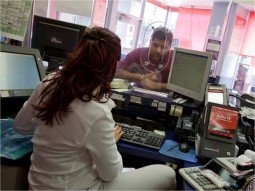
Americans don’t save enough. Richard Thaler, a behavioral economist at the University of Chicago, writes in the
New York Times that we know how to make people save more for retirement. We need to make payroll retirement accounts available to everyone. And we need to make sure that enough money is automatically deposited into those accounts.
We all have a finite stock of mental effort, and we tend to stick with the default option. So workers not signed up automatically for a 401(k) plan tend to procrastinate for too long before making contributions. When they do, they often make the low, default payment. One
solution is proven and remarkably simple: automatically sign up employees for the plan, set the default contribution at a meaningful level, and increase those contributions as employees earn more. Shlomo Benartzi and Thaler
estimate that thanks to these programs:
"...more than four million people were using some form of automatic escalation, and had collectively increased annual savings in the United States by over $7 billion a year."
Here at
IPA we’re excited about the promise of automatic savings. In collaboration with
Self-Help in California and
RiteCheck in New York we’re putting that idea into action to help the poor save more. We call the product “frictionless savings.” Millions of Americans use check cashing services in place of a regular bank account. For a fee, they’re able to quickly and conveniently cash their checks. But it’s a lot harder to save.
Frictionless savings helps to solve this problem. Say you cash a check for a hundred dollars. The teller asks you if you would like to set up a savings account, with five dollars from the check going into the account. And then each time you cash a check, you pre-commit to having five dollars automatically deposited into the savings account. The process is seamless and doesn’t need mental effort. This way people can slowly build savings and savings habits, and even a few hundred dollars can help people weather unexpected shocks like car repairs or a medical emergency. Frictionless savings can have the added benefit of
transitioning consumers into using more mainstream financial services.
We’re still piloting frictionless savings, but people understand that they’re more likely to save if the process is automatic, and we now know that there is demand for the product. We’re also interested in a whole range of applications that use automation to help people better manage their finances. These include a “Pay Yourself Back” model that seamlessly switches consumers from making monthly loan payments to making savings deposits once the loan is paid off. Small nudges that are relatively low cost can have big effects on our behavior, and we want to understand how best to design, market, and rigorously evaluate those interventions. If you’ve got ideas, get in touch with
IPA’s US Household Finance Initiative.
 Americans don’t save enough. Richard Thaler, a behavioral economist at the University of Chicago, writes in the New York Times that we know how to make people save more for retirement. We need to make payroll retirement accounts available to everyone. And we need to make sure that enough money is automatically deposited into those accounts.
Americans don’t save enough. Richard Thaler, a behavioral economist at the University of Chicago, writes in the New York Times that we know how to make people save more for retirement. We need to make payroll retirement accounts available to everyone. And we need to make sure that enough money is automatically deposited into those accounts.











